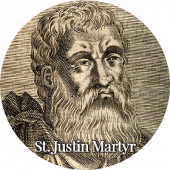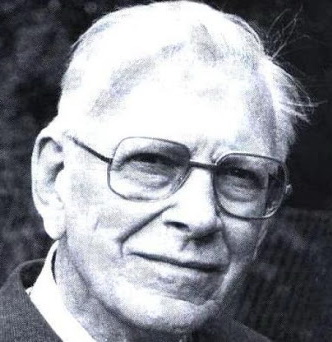
RICHARD DE SMET (1916-1997)
I have been reading Richard De Smet’s work for years and have found him to be the deepest and most erudite interpreter of Indian thought from within a traditional, Christian metaphysical framework. I have drawn comparisons between him and the author whose work I recently anthologized here: “Bernard Kelly, Richard De Smet and the Dialogue Between Thomas Aquinas and Advaita Vedanta“. Below is an encyclopedia article on De Smet by the editor of two recent collections of the Jesuit’s work.
From forthcoming 2nd edition of the Encyclopedia of Philosophy of the ACPI (Association of Christian Philosophers of India) – entry written by Ivo Coelho (printed with permission):
Richard Vital De Smet, SJ, eminent Jesuit Indologist and missionary to India, was the Founder-President of the ‘Association of Christian Philosophers of India’ (ACPI), serving from the inception of the Association in 1975 up to 1994. He was born at Charleroi, Belgium in 1916, joined the Jesuits in 1934, took his vows in 1936, and completed his graduation in classical philosophy in 1938. The study of philosophy, which he began in 1939, was interrupted by the outbreak of World War II. In 1941, he resumed his philosophical studies, coming under the influence of Joseph Maréchal (1878-1944) and his disciples, and also of the Indologists Pierre Johanns and Michel Ledrus. Having opted for the missions, De Smet arrived in India in 1946 and began a systematic study of Hinduism as well as of Sanskrit. He was fortunate to be surrounded by Indologists of note such as J. Putz, J. Bayart, G. Dandoy, R. Antoine, and P. Fallon.
Provoked by a talk by Dr S. Radhakrishnan (1888-1975) at the silver jubilee session of the Indian Philosophical Congress at Calcutta in 1950, in which the famous professor claimed that Śaṅkara was a philosopher, De Smet decided to show that Śaṅkara was, instead, a śrutivādin – a theologian who subordinated reason to the revealed (apauruṣeya) scriptures. De Smet went on to gain a doctorate from the Gregorian University, Rome, in 1953, with a thesis on the theological method of Śaṅkarācārya.
Returning to India in March 1954, De Smet began to teach at the newly opened centre for philosophical studies of the Jesuits at De Nobili College, Pune. At first, he was assigned courses that are traditional in Roman Catholic seminaries. But he also introduced a course on Sāṃkhya and inserted ‘large doses of Indian philosophy’ into the traditional treatises. By 1968, he was able to open a special section for Indian Studies in the centre, now renamed Jnana Deepa Vidyapeeth. While others such as Joseph de Marneffe and Gaspar Koelman took over his previous courses, De Smet dedicated himself to developing a ‘full course on Hinduism’ spread out over the three-year Bachelor’s and two-year Master’s degree courses. Over the years 1968-75, he composed notes for students under the title Guidelines in Indian Philosophy. Through his work as professor he became mentor, guide and friend to numerous scholars, young and old.
From the very beginning of his academic career De Smet began attending various meetings of Indologists and Indian Philosophers: the Indian Philosophical Congress, the Poona Philosophy Association, the Bombay Philosophy Union, the newly formed Association of Christian Philosophers of India, etc. After an initially suspicious reception (Dr Chubb roundly accused him of excessive missionary zeal at the Kandy session of the Indian Philosophical Congress in 1954), his competence and self-possession won the day and he soon found himself being invited to lecture at a number of Indian universities such as Varanasi, Shantiniketan, Nagpur, Ahmedabad, Vishakapatnam, Madras and Delhi. Eventually the dialogue became bilateral, with De Smet being asked to read papers on various points of Christian doctrine. The visit of Pope Paul VI to India in 1964 and his warm invitation to interreligious dialogue caught the imagination of many. In the decades that followed, several Indian universities decided to extend their programme to the study of world religions, and De Smet was one of those who was approached for advice regarding syllabus. He even received a delegation from the Indian Army, seeking advice on the same point.
Another important focus of De Smet’s activity was his dialogue with religious people. He was a frequent invitee to the Sivananda Ashram at Rishikesh, where he would lecture on Indian spirituality, but also, on request, about Jesus and Christianity. He visited the Ramakrishna missions in various parts of the country, and the Aurobindo Ashram at Pondicherry. He had contacts with the Caitanya Vaisnava movement at Vrindavan. Invited by the Sikhs to the four hundredth anniversary celebrations of their founder, he spoke about the similarities between Guru Nanak and Jesus Christ. Despite not being an expert in Islam, he found himself being invited also by Muslims of the Jamia Milia University in Delhi. He spoke often to the Jains of Pune and wrote for their Voice of Ahimsa. He was also in touch with the leading figures in the Christian ashram movement. He participated in the pro-dialogue meetings organized by Swami Abhishiktananda (Henri Le Saux) under the patronage of the Swiss Ambassador, J.-A. Cuttat. He was invited for lectures on Hinduism to the Kurisumala Ashram founded by Francis Acharya (Francis Mahieu) at Vagamon, Kerala. He also engaged willingly with Christians of other denominations, whom he liked to call ‘our converging brethren,’ teaching in their universities and seminaries and participating in their conferences, meetings and seminars, far before the word ecumenism became popular in the Catholic Church. But even these contacts had as their aim the wider ecumenism in the sense of fraternity among members of all religions, rather than ecumenism in the strict sense of dialogue between Christians.
What goes by the name of dialogue often remains at the level of talk about dialogue. De Smet has the distinction of having actually engaged in interpersonal encounter over almost half a century. His dialogical style was distinctive. In contrast with someone like Abhishiktananda who insisted on the experiential to the almost total exclusion of the theoretical, De Smet brought to dialogue not only a Christianity open to learning from other religions and cultures but also his Indological competence and great self-possession coupled with gentleness. In contrast with many other Catholic contemporaries who assumed they could approach Hinduism only by jettisoning the Greco-Roman inculturation of Christianity, De Smet’s approach was marked by a deep appreciation of both Hinduism and Christianity in their historical evolution. Such an approach amounted to a rejection of the Principle of the Empty Head and a handling of historicity by a deconstructive appropriation of the two traditions and the achievement of a fusion of horizons. In contrast to the option of excising in advance anything that might seem objectionable to the dialogue partner, De Smet avoided any dilution of his innermost convictions and was a firm believer in the importance of identity in dialogue.
De Smet has sometimes been accused of attempting to impose Christian and scholastic categories on Śaṅkara. This kind of objection stems, once again, from lingering Enlightenment presuppositions and an incomplete recognition of the inevitable historicity of our being. De Smet recognized, in practice far before he did so in principle, that it is simply impossible to pretend to a presuppositionless objectivity, and that the only way to approach the other is by deconstructively engaging one’s own tradition, through such self-knowledge and self-appropriation as is possible to us.
De Smet will be remembered for two major contributions to Indological scholarship. The first was his fresh interpretation of Śaṅkara as a non-dualist realist rather than a world-denying illusionist. This interpretation hinged on his discovery, or rather reinforcement, of Olivier Lacombe’s discovery, of the fact that Śaṅkara used analogical predication in expounding the meaning of the mahāvākyas (great sentences) of the Upaniṣads such as Tat-tvam-asi and Satyam Jñānam Anantam Brahma. The world is neither atyanta Sat like Brahman, nor atyanta Asat like the son of a barren woman. It is, instead, a reality that is completely and ontologically dependent on Brahman. And once the notion of creation is purified of anthropomorphism, it is possible to speak of Brahman as creator and cause of the world, without detriment to its oneness, immutability, perfection and freedom. The second was his demonstration that, given the original meaning of ‘person’ which was coined by Christian theologians to speak precisely of the divine mysteries of the Trinity and the Incarnation, the supreme (nirguṇa) Brahman, far from being impersonal, is indeed personal in the highest and supreme sense of the term.
De Smet passed away in Belgium on 2 March 1997. In an evocative phrase, his friend and former student Julius Lipner called him one of the ‘unsung pioneers’ of the interpretation of Indian thought, and said that his passing away marked ‘the end of an era in the annals of Indological scholarship in India,’ the era of ‘the foreign missionary scholar who made India a home over many years, loved its peoples and its cultures, empathetically studied rich strands of its religious inheritance, and sought in a spirit of enlightened appreciation to enter into a dialogue at depth.’
Early in his career, De Smet made the option to meet requests arising from his dialogical activity inside India rather than to engage in sustained Indological research. He also decided to give preference to the requests of Hindus, Jains, Sikhs, Muslims, etc. over those of Christians. As a consequence, most of his production consisted of occasional pieces in a wide variety of relatively inaccessible Indian publications. This resulted in his hardly being known outside India. Even in India, the scattered nature of his output has resulted in his largely being ignored in Christian theological circles.
Among De Smet’s books may be counted the following: Philosophical Activity in Pakistan (1961), Religious Hinduism (editor, with J. Neuner) (1964, 1968, 1997; German translation 1962, French translation 1967) and La théologie en Inde. His articles and reviews, instead, are too numerous to be listed. The process of editing and publishing his articles in a series of books has already begun, with two collections already in print: Brahman and Person (2009) and Understanding Śaṅkara (2013) and a third in preparation (Guidelines in Indian Philosophy, but already serially published in Divyadaan: Journal of Philosophy and Education vols. 20-30, 2009-2019). Two Festchrifts were being planned, one in Jnana Deepa Vidyapeeth and the other abroad, for De Smet’s eightieth birthday; unfortunately, both were published only after his death. There is a small but growing body of secondary literature on De Smet, but much still remains to be done by way of study of the reception of his interpretations by scholars and others in India and abroad.
BIBLIOGRAPHY
Coelho, I., ed., Brahman and Person: Essays by Richard De Smet, Delhi: Motilal Banarsidass, 2009; id., Understanding Śaṅkara: Essays by Richard De Smet, Delhi: Motilal Banarsidass, 2013; id., “Fr. Richard V. De Smet (1916-97): Reminiscences,” Divyadaan: Journal of Philosophy and Education 8/1 (1997): 10-11, 13-14; id., “Richard V. De Smet, SJ: A Bibliography,” Divyadaan: Journal of Philosophy and Education 20/1 (2009): 109-157; id., “Richard V. De Smet, SJ (1916-1997): A Life,” Divyadaan: Journal of Philosophy and Education 23/1 (2012) 1-72; Grant, S., Śaṅkarācārya’s Concept of Relation, Delhi: Motilal Banarsidass, 1999; John, Giri K., Brahmajijñāsā of Śaṅkara as Theology: A Post Colonial Appraisal, Kolkata: Punthi Pustak, 2013; Kozhamthadam, J., ed., Interrelations and Interpretation: Philosophical Reflections on Science, Religion and Hermeneutics in Honour of Richard De Smet, S.J. and Jean de Marneffe, S.J., New Delhi: Intercultural Publications, 1997; Malkovsky, B., ed., New Perspectives in Advaita Vedanta: Essays in Commemoration of Professor Richard De Smet, SJ, Leiden / Boston / Köln: Brill, 2000.



